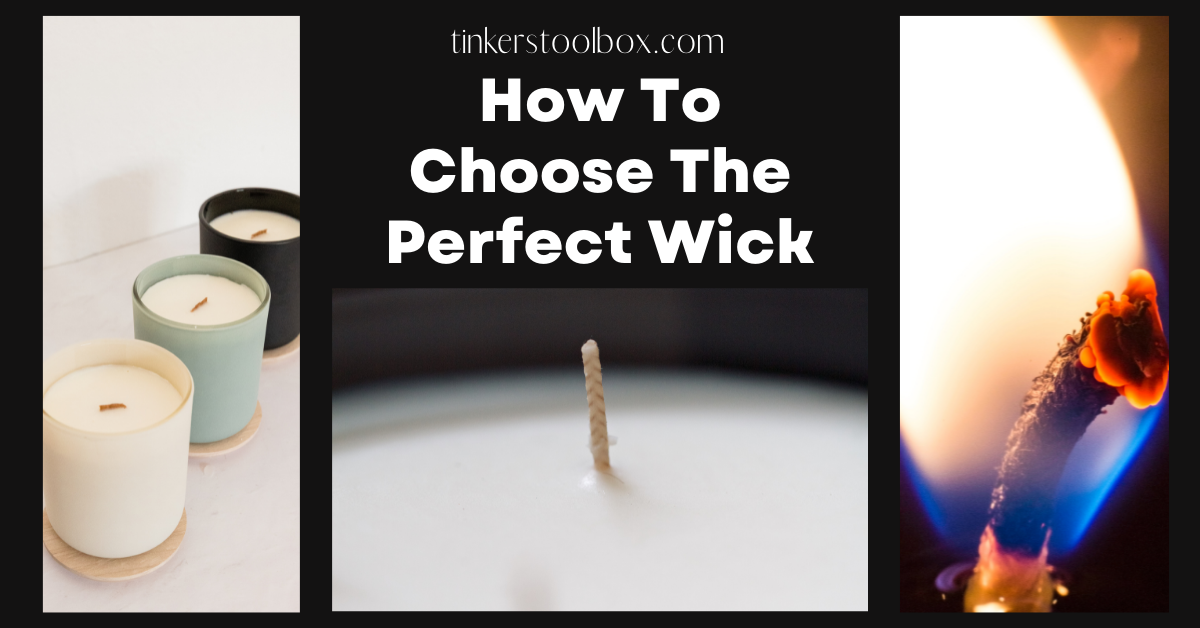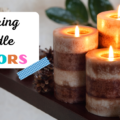Every candle requires a wick. Candle wicks are important candle elements since they dictate how the candle burns and distributes scent throughout the area. With the role of a candle wick in your candle projects, it will be crucial and hard to select the best wick for your candles, but it is doable.
It would be best to choose your candle wicks based on the compatibility of the wax type, the candle size, and the purpose of your candle. It is recommended to use multiple wicks for larger candles to achieve an even melt pool. Also, always maintain a good wick length to get a consistent flame.
Choosing a wick can be tricky and challenging, particularly knowing where to start. This knowledge and skill come with experience and a lot of testing. Do not worry, though, because I compiled the easiest ways to choose a wick that will suit your needs, especially for novice candle makers.
- Choose A Wick Based on Candle Wax Type and Diameter
- Choose A Wick Based on The Candle’s Functionalities
- Choose A Wick Based on Personal Factors
- More on Candle Wicks: Types and Tips
- How To Know If You Have Chosen the Right Wick
- Reasons Why You Need to Choose The Right Candle Wick
- Do Not Be Afraid To Choose A Wick And Light Up That Candle!
Choose A Wick Based on Candle Wax Type and Diameter

When choosing a wick for your candle, you should remember the candle type and size. The candle size is best described by its diameter.
Wax Type is Your Number One Priority
Each variety of candle wax has a unique melting point and density that should be considered when choosing a wick. The common wax types used in candle making are soy, paraffin, and beeswax.
Among the three, paraffin was the most popular for a good reason. According to some studies, it is reliable and affordable but is less safe than soy and beeswax.
The wax moves through the wick and lights the candle up through capillary action, and the wax density can influence how the wax may move through the wick.
At the same time, soy wax burns longer and slower than paraffin wax, so a thinner wick may be preferable.
Luckily for beginners, there are already wax selection tables available online where you can start with the recommended wick for specific wax types.
Candle Diameter and Its Need For the Correct Wick
Candle diameters are important considerations in choosing a wick. Increasing the number of wicks is essential to achieve a full burn pool when candles are too large to meet with a single wick.
You can decide what wick size you will get by making three candles and using different wick sizes. Candles larger than 3 inches may benefit from multiple wicks around two to four. To know more about using three candle wicks, I wrote a detailed article that you can check.
If you are only using a single wick in a large diameter candle, an uneven burn may happen, which will shorten your candle’s life. See what happens and choose the best result you can get.
Choose A Wick Based on The Candle’s Functionalities

There is nothing compared to the benefits candles provide to your mood and needs; hence it is beneficial to consider using a wick based on the candles’ intended purpose.
Burn Time Equals Longer Relaxation Time
If you want to burn the candle in shorter intervals, rather than the suggested four hours, a larger wick is preferable to avoid funneling by forming a melt pool quickly over the candle.
The wick material should also be considered since some wick materials, regardless of size, may burn faster.
You may also want to use Braided, plaited, or knitted fibers to make high-quality wicks because they promote a steady and constant burn.
Crooked wicks are of lower quality because they burn more quickly due to their loose design, allowing them to reach the flame more quickly. Birthday candles are the most common usage for these.
Fragrance Oils and Wick Interaction
Considering that candles also give you pleasurable scents in your space, how much smell or color you want to put in the candle is also a factor in choosing a wick.
You will want your wick to be thicker if you’re using a lot of color or smell. Thicker wicks also burn hotter, so use them in large diameter candles.
Choose A Wick Based on Personal Factors

Aside from the mentioned considerations in choosing a candle wick, it would help if you also chose based on your preferences. It is important to choose based on your liking to be excited about doing the candle project. Of course, without sacrificing the candle quality and output.
Cost: Be on Budget
Some wicks may cost more than others, depending on the material used. If you are on a budget, you can use cheaper options as long as it does not compromise the quality of your candle.
Fortunately, this does not often happen since wicks are one of the most affordable candle elements, and this should not cost too much of your candle-making expenses.
It only gets expensive if you purchase luxury candles and candle-making kits that will include the wick.
Cotton wicks are the cheapest costing only around five dollars for 50 pieces of wick and wick tabs. Wooden wicks can cost around $20, and organic hemp wicks can cost $25.
The thickness is also a reason why wicks are priced. There are many options, and you have to research to choose the perfect wick.
Preference and Your Taste
Some candle makers want to make eco-friendly candle waxes, choosing wood or cotton over other materials. Wood sounds different when burning, which can give a satisfying feeling to your senses. The most common wicks are made from paper, zinc, and cotton.
The wooden wick can be made from hardwood and softwood that produce a crackling and popping sound as they burn. This distinct sound can be relaxing while the wicks are burning.
Since using wooden wicks is not usually done, you should remember that they rarely need to be trimmed, unlike cotton wicks. However, each hardwood wick has unique qualities because it is a natural product.
You may occasionally notice a knot’s traces, which can slightly affect the wick’s performance. If this happens, break the burnt wooden wick’s upper portion.
More on Candle Wicks: Types and Tips

If you are still lost in choosing a wick, other tips and information to help you decide on your next candle project are mentioned below.
Get To Know The Types of Cotton Wicks
Cotton wicks are widely used for candle making, and it has two general types, namely flat, braided, and cored wicks. Flat wicks are three fiber bundles that burn evenly and curve in the flame to provide a self-trimming look.
They’re commonly found in pillar and taper candles. These square wicks are best used with beeswax.
At the same time, wicks that are braided curl in the flame. Braided wicks are thicker and more rounded than flat wicks. When burning, they are meant to flex slightly near the tip.
Lastly are cored wicks that burn straight or upright while burning. Container candles, pillar candles, and votives all use cored wicks.
For any wick types, pre-waxing these candle wicks is suggested to improve their stiffness and efficiency.
Other Wicks You Should Check
Self-trimming wicks, also called HTP wicks, are stiff like cored wicks but compared to cored candle wicks, they produce better wax pool symmetry and less carbon burning.
In common candle waxes like soy, paraffin, and palm wax, HTP wicks function admirably.
Next is the Performa cordless wicks, made of cotton and exceptional because of their braiding, allowing them to remain upright and not bend while burning.
Also, the distinctive braiding on LX wicks is one you should check out. They are unique, being coreless with stabilizing threads promoting a good burn which is a character of flat wicks.
LX wicks are even greater because they produce a consistent and very stable flame. A flame that produces less soot and smoke. It’s a wonderful choice for containers and pillars since it improves paraffin and soy wax burning.
You can also check the RRD series wicks. These round braided cotton cored wicks are recognized for keeping a steady flame. These wicks boost the amount of fuel, aroma, and wax flowing to the flame.
Last are CD wicks with a flat braid shape with a specific paper filament woven around them. Like Performa’s wicks, they are coreless.
It is designed to provide a constant and maximum burn. CD wicks perform well with waxes that are difficult to melt, such as paraffin and soy waxes.
How To Know If You Have Chosen the Right Wick

Naturally, you cannot get the right combination on the first try, and choosing a wick is experimental. So, to know if you have chosen the right wick in all your experiments, here are the indicators you should look for.
It Should Pass The Candle Test
If you already have your candle and wick, you can do a candle test to see how it will turn out. You can start with a standard burn test, and this should be a part of your candle production if you are into candle selling.
In a standard test, you will burn the candle for four hours or until the end of its burn time. After that, check if the candle tips on its own. It has more than one flame in a single wick, and the flame height exceeds three inches. Also, if the candle’s surface is damaged and the container cracks. If it fails, you should re-do your candles.
You can also do a normal burn test if making candles only for your personal use. It would be best to do this to simulate the normal usage of candles. You can observe how it will behave and adjust it if needed.
There Should Be No Mushrooming, Tunneling, and Excessive Flickering
When a wick splits as it burns, it is known as mushrooming. There are two things you can do to avoid this. You can trim wicks after use, remove excess build-up or choose a thinner wick.
On the other hand, a tunnel will form if the candle does not melt from edge to edge, and your scent throw will be weak. Candles develop tunnels if the candle is only burned for a brief time before the melting pool can reach beyond the candle’s diameter.
For optimal effects, light candles at 4-hour intervals. It may also be tunneling because the wick was too thin and lacked the strength to form a complete melting pool.
At the same time, excessive flickering can indicate that you have used the wrong wick. Unlike a wood wick, a flickering wick may emit smoke or soot. A common source of wick difficulties in candles is a too thick wick for the candle size.
Watch Out For Deep Melt Pools In Your Candles
Keep an eye out for this. It can be caused by using a wick that is too thick for the diameter of the candle can result in a melt pool of more than half an inch. A large melt pool can drastically reduce the quantity of burn time, hence the candle’s life.
The deep melt pools may also be caused by fragrance oil, which is known to have a significant impact on the burn.
Reasons Why You Need to Choose The Right Candle Wick

Wicks are usually the last thing beginner candle makers think about, and this may be a bad practice because wicks convey the lifeline of the candles. If you are not yet convinced to put this on top of your list and add this to your skills, here are some reasons why you should.
A Right Wick Is Needed To Achieve a Consistent Flame
Flames produced by candles should be consistent with a size enough to melt the candle without breaking the container and producing less soot. The melt pool should also be even across the diameter of the candle.
The flame produced by your candles should be big enough to create heat in the atmosphere and throw scents incorporated into it. It will only produce less heat if it is too small and might self-extinguish.
A Right Wick is Essential For A Safe and Moderate Temperature
Wick sizes again impact the size of the flame produced; hence it is crucial to have the right wick size to avoid accidents. The right flame size will be safe and will only produce the optimal temperature that the container can tolerate and will not harm the surface the candle sits on.
A Right Wick Produces Less To No Soot While Burning
Wicks that are too high produce more soot than right size wicks. Also, it would be best if you trimmed wicks properly to keep the flame size right and produce less to no soot.
It would be best to choose wood or cotton wicks than lead wicks since the latter produces more carbon when lit. For this reason, the correct wick length and material are needed to produce a good candle.
A Right Wick Has a Longer Burn Time
If you choose the correct wick for your candles, you will enjoy your candles longer since they will burn longer. On the first burn, keep the wicks to ⅛ inches; then, trim it to make it last even longer when relighting.
The right wick will melt the candle evenly, conveying fuel to the fire, and will keep your candles in a good state for a long time.
Do Not Be Afraid To Choose A Wick And Light Up That Candle!
Choosing a wick is a work in progress and a trial and error system that will take numerous experiments, but it will be smooth sailing once you know the process. Through this guide, I know you will gain the confidence to choose the perfect wick for you, and once you find the one that fits your criteria, it will be fulfilling and a great experience from there.















